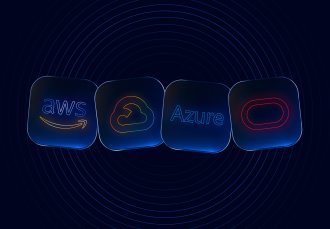
Contact us
Our team would love to hear from you.
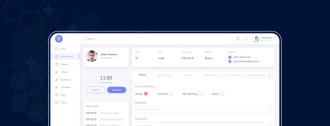
Recent decades have witnessed a rapid digital transformation of healthcare driven by advancements in mobile health technologies (mHealth), the implementation of electronic document management (EDMS), medical analytics, and telemedicine. IT platforms facilitate data exchange between healthcare providers and improve service delivery to patients without compromise to regulatory compliance. Modern software solutions increase the efficiency and productivity of medical assistance by automating routine administrative tasks and providing additional control over the quality of medical services. EHR is one such solution.
EHR (Electronic Health Records) and EMR (Electronic Medical Records) are the acronyms a lot of healthcare professionals find confusing, or use interchangeably. It is not surprising since both terms refer to a digital record with patient data that allows remembering, storing, using, and maintaining patient information: first name, last name, demographics, visits, diagnoses, test results, allergies, contraindications, and so on. The fact is that the terms have distinct differences in meaning. The EMR provides a narrower range of functions for handling a patient’s medical history than EHR.
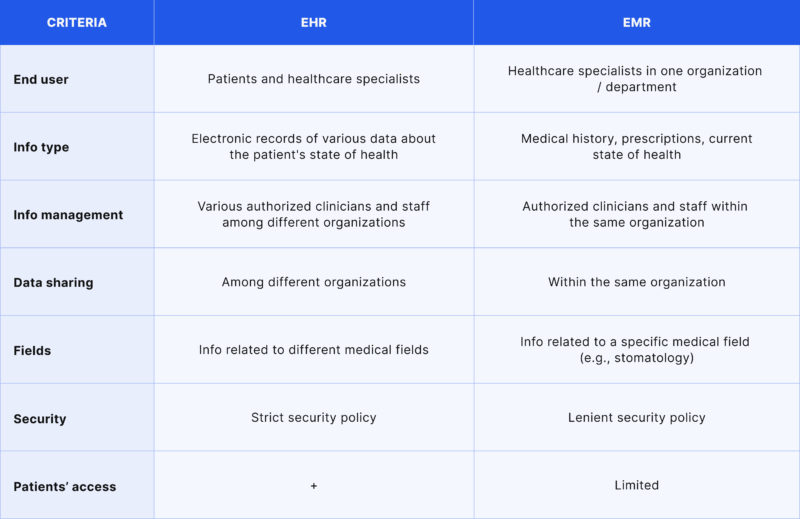
What is the difference between EHR and EMR
Electronic health record systems have plenty of advantages.They represent secure, regulatory compliant systems and are easy to use. To find health information, there is no need to spend a lot of time searching through pages of medical charts because all the data can be quickly found in the digital version of records by entering the appropriate query.
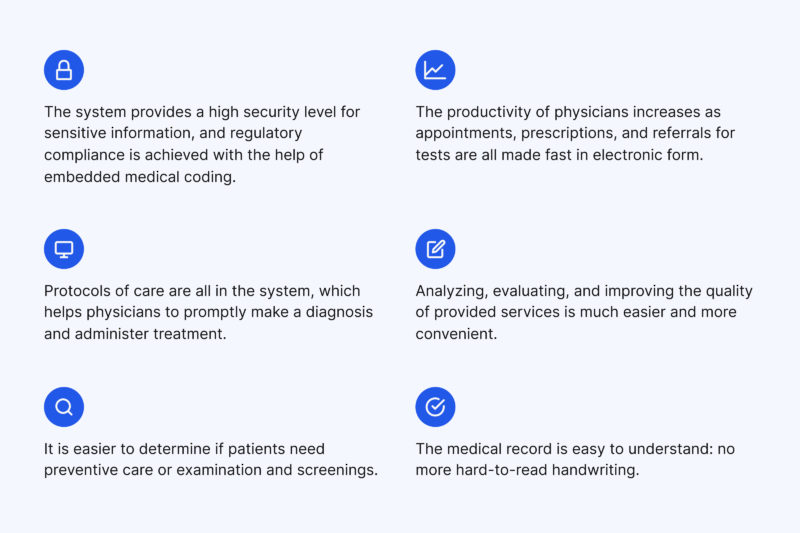
Advantages of electronic health records
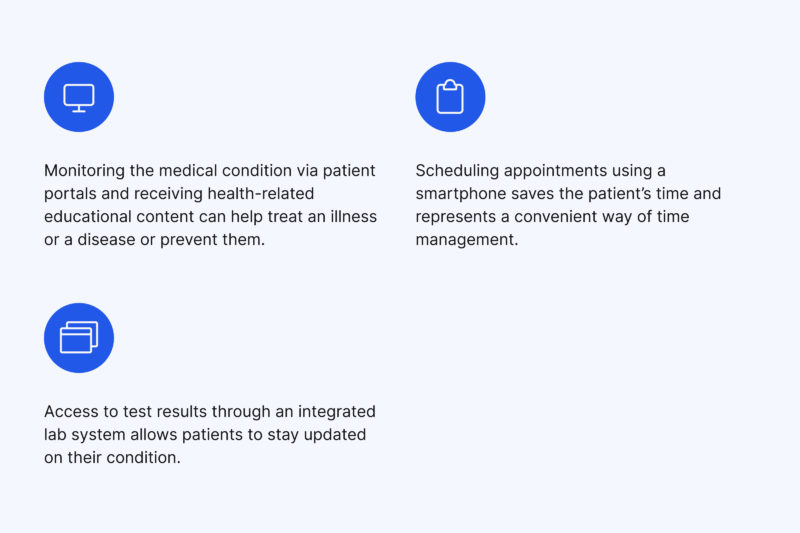
Key advantages of EHR for patients
The healthcare industry standards is subject to a number of very strict legislative acts that, surely, differ from country to country. For example, each EU member state has its own rules on EHR software. More information on national laws in the EU and Norway is available on the European Commission website.
However, there is a regulation that every business in Europe, from small to large, must comply with — the GDPR (General Data Protection Regulation). It governs data privacy and security with regard to EU citizens.
As for the US jurisdiction, the official website of the ONC provides comprehensive and all-encompassing information on Health IT Legislation. The HL7 (Health Level Seven) standard for the exchange, integration, sharing, and retrieval of electronic health information is a mandatory regulatory act EHR systems are subject to. But the most crucial regulation that all healthcare software in the US must comply with is HIPAA (Health Insurance Portability and Accountability Act).
One of the essential HIPAA requirements for EHR use is safeguarding the PHI (Public Health Info), identifiable health information which usually includes medical and personal data. These two types of data must be kept separately to ensure better security of health information. The HIPAA compliance not only benefits the EHR system’s users, but also imposes certain obligations on EHR systems’ vendors.
In order to meet the requirements of HIPAA security, EHR developers have to:
Although EHR systems have their own key functions designed to meet the demands of the business they are developed for, there are some common must-have features that modern EHR systems cannot be imagined without.
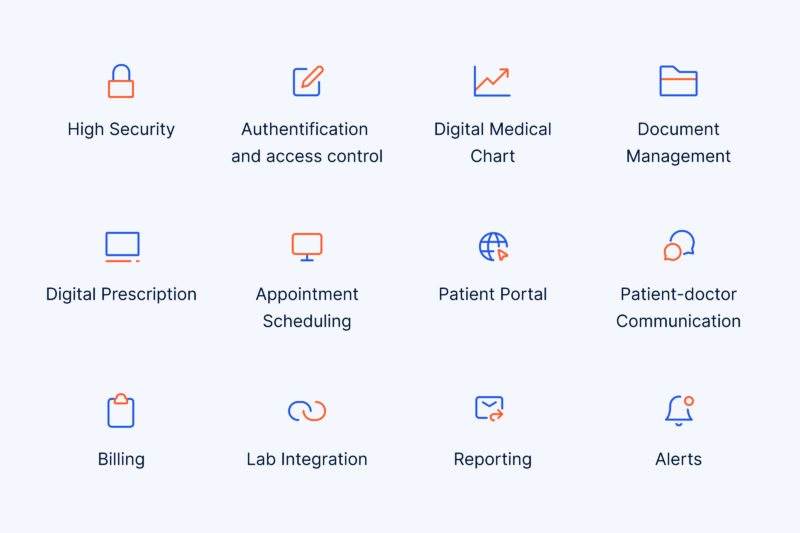
The unique features of electronic health record software
According to HIPAA, all EHR systems must be provided with high security of data storage and sharing. It means that data transmitted or stored on servers is to be encrypted. Therefore, patients can be assured that their personal information is securely protected.
This feature primarily ensures that only authorized users have access. Since EHR systems deal with sensitive information, it is imperative to provide authentication which is required to access the application. It is not only a basic HIPAA requirement, but also a handy tool for assigning responsibilities. When setting up the access rights, it is very important to limit users’ functions according to their role and determine who can create and manage records containing certain information. This guarantees that physicians receive only the reliable data they need.
It is the most crucial module intended to eliminate paperwork from the doctors’ workflow. The EHR chart represents an electronic, real-time, patient-centered record that provides information instantly and securely to authorized users. Moreover, modern technologies also allow implementing machine learning algorithms that analyze data and can suggest the treatment, which can simplify the decision-making process.
EHR systems provide a convenient management of healthcare documents: the patient’s medical history, lab results, and other documents related to the treatment and the patient’s state of health. At EffectiveSoft, we have significant experience in developing of document management software.
Electronic prescriptions is another important feature for the modern healthcare system. The system provides patients with the possibility of requesting prescription refills as well as automatically generates suggestions. In addition, the prescriptions module enables an authorized person to view what other drugs the patient takes, which helps prevent potentially hazardous drug interactions. Finally, the easily accessible information considerably reduces the risks of wrong dosage. Patients can also clarify the instructions for use and report side effects if they occur.
The patient portal is a means by which patients can access their health information: diagnostic test results, drug refills, treatment history, insurance information, and more. This feature encourages better patient-doctor relationships and gives patients more control over their health.
Being able to communicate directly and securely is one of the most attractive features for both patients and doctors. Messaging is an easy way for patients to ask questions about their health and get trustworthy answers from their doctors, as well as to schedule appointments.
Patients can book, schedule, or cancel their appointments with a few taps on their smartphone from anywhere.
A lab system can be developed as a part of the EHR software or as an integrated 3rd party system. Such implementation allows scheduling tests, tracking and receiving the results in a convenient, fast, and almost effortless way.
Detailed meaningful reporting allows healthcare providers to get insights into the ongoing processes, measure results, and estimate service efficiency. This feature is of great help in improving the quality of delivered services.
This feature updates healthcare providers and patients on the next steps that need to be taken and the timing of concrete activities. The system also sends reminders, e.g., the appointment reminder.
All advanced EHR systems have a medical billing dashboard. It allows automatically generating invoices after each appointment, sending claims to the patient’s insurance company, and handling denials or unpaid claims.
Today’s EHR market offers a range of EHR systems with all of the above features that are still unique in their own way. According to Forbes, the top three EHRs are the following:
The solution is recognized as the best EHR software for iOS mobile use. In fact, DrChrono was the first company to create a native EHR app that allows access to data on iPhone or iPad. DrChrono is an all-in-one cloud-based platform for medical billing and patient management. It runs only on Apple devices.
This is a web-based EHR system designed for independent practices. Practice Fusion provides a low-cost monthly fee and offers flexible licenses for the unique needs of a practice.
It is a web-based patient management solution for medical providers recognized as the best for small practice medical billing. It suits those who want to handle their billing in-house and avoid outsourcing.
EHR software development is a complex process that requires constant cooperation between the business owner and development team. We at EffectiveSoft are strong adherents to the Agile philosophy. Healthcare institutions usually act as business domain experts while we provide technical expertise and translate business requirements into user stories.
Like any project, EHR software development should be started with careful research and planning. To build your development strategy, you need to answer the following questions:
You do not have to find the answers on your own. Our top-notch Business Analysts can help you strategize the solution that suits you best.
Before starting the realization of the idea, EHR developers carefully study the rules and regulations the software is subject to in order to ensure that all the information in it is safeguarded. Then, the team makes a plan of how to apply the security rules and starts building the system. The compliance checks are made on every step of the EHR development process.
When developing, we usually plan 2-4 weeks long iterations. Our healthcare software developers not only interact with each other, but they also constantly keep in touch with the client. At the end of each iteration, the team demonstrates the tested incremental value to the business owner. If there is a need to make some adjustments, this is always possible. Iterations are repeated until the software is completely ready.
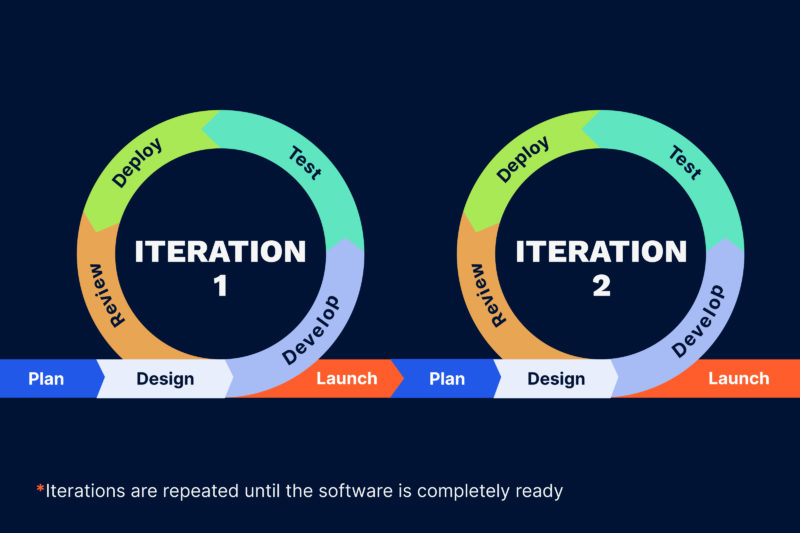
EHR workflow process and development stages
Once the software is in place, the next step in the EHR implementation is data migration. Then proceed with the digitalization and creation of an EHR data platform to store relational data, non-relational data, and metadata. During the ETL process, it is important to follow a phased approach where data is first deployed to the staging environment, then tested, and afterwards deployed to production to ensure complete seamlessness.
Now the system is ready to be launched. But before fully integrating the EHR software into the workflow, you need to provide the user adoption. Train your staff to ensure success of the EHR implementation. When your organization is prepared, it is time to run the EHR system and start using it.
It is the last and never-ending stage which includes fixing eventual defects and enhancing the EHR system. This stage is aimed at keeping up with the healthcare industry trends and legislation updates.
Each software development company offers a different range of technologies they use in EHR software development. The choice of the tech stack should be based on your individual business needs and the result you want to achieve.
We at EffectiveSoft follow a case-by-case approach and will be happy to suggest the tech stack and deployment platform to ensure security, compliance, high availability, and fault tolerance of your EHR software.
EHR is a complex and expensive software solution. If you decide to implement a new one, we advise you to evaluate off-the-shelf and custom-made alternatives to see if there is a trade-off between these approaches. It is often a good idea to use a hybrid approach, which is when an out-of-the-box solution is applied as the foundation and custom functionality is built on top of it. A vital step on this path is to choose a reliable vendor.
At EffectiveSoft, we have gathered dedicated developers with relevant experience who will be happy to bring your product to life. Contact us to learn more about our expertise.
Our team would love to hear from you.
Fill out the form, and we’ve got you covered.
What happens next?
San Diego, California
4445 Eastgate Mall, Suite 200
92121, 1-800-288-9659
San Francisco, California
50 California St #1500
94111, 1-800-288-9659
Pittsburgh, Pennsylvania
One Oxford Centre, 500 Grant St Suite 2900
15219, 1-800-288-9659
Durham, North Carolina
RTP Meridian, 2530 Meridian Pkwy Suite 300
27713, 1-800-288-9659
San Jose, Costa Rica
C. 118B, Trejos Montealegre
10203, 1-800-288-9659